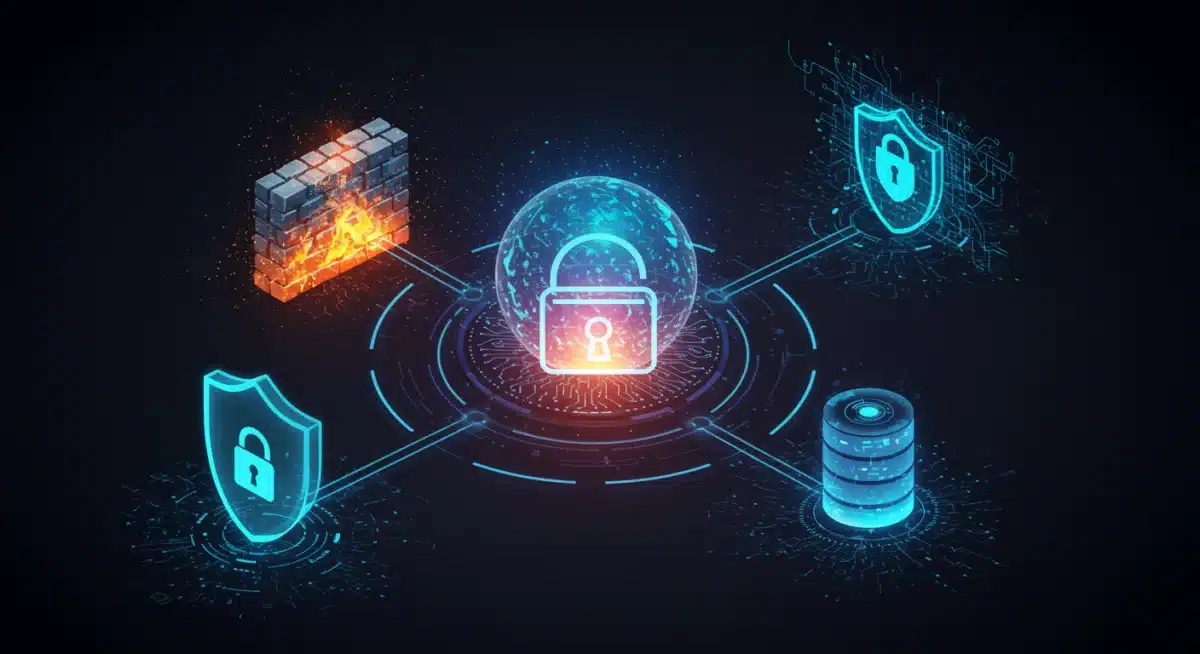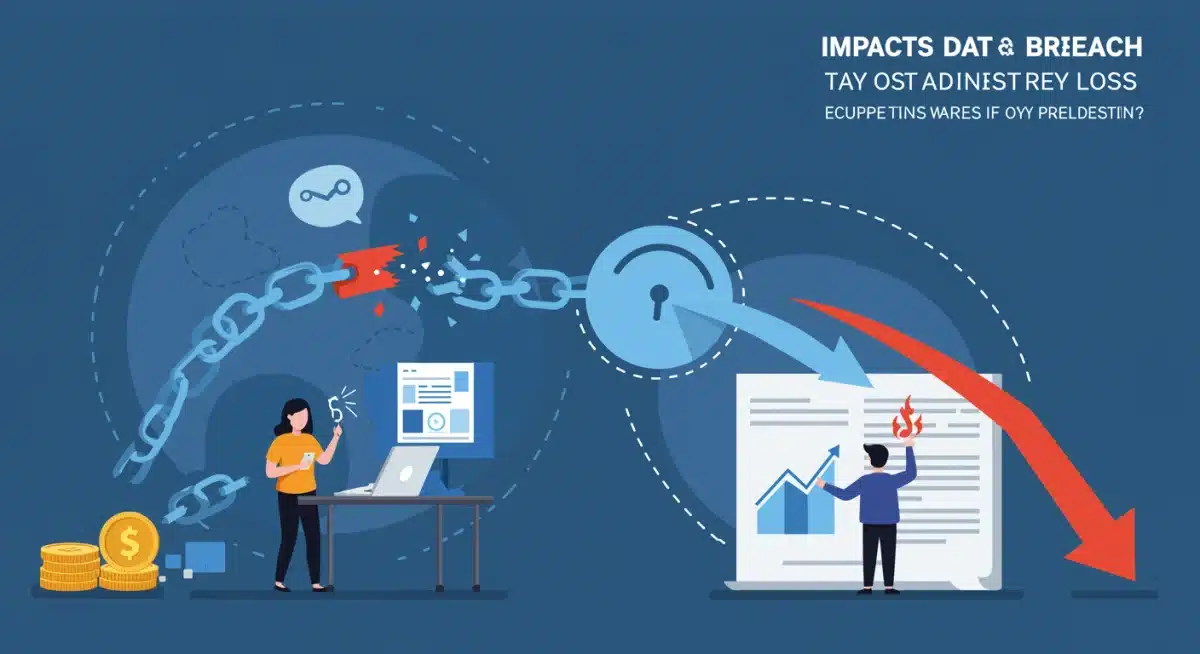Cybersecurity for Small Businesses: Protect Your Digital Assets

In today’s digital economy, small business cybersecurity is paramount for protecting vital digital assets against an ever-evolving threat landscape, requiring proactive measures and continuous vigilance to ensure operational continuity and data integrity.
Small business cybersecurity is no longer a luxury but a critical necessity for survival in the current digital age. As cyber threats become more sophisticated and prevalent, small businesses, often seen as easier targets than larger corporations, must prioritize the protection of their digital assets. This article provides timely, factual information on the evolving threat landscape and offers actionable strategies to safeguard your enterprise.
The Evolving Threat Landscape for Small Businesses
The digital realm has brought unprecedented opportunities for small businesses, enabling wider reach, streamlined operations, and innovative service delivery. However, this increased connectivity also exposes them to a growing array of cyber threats. From ransomware attacks that encrypt critical data to phishing schemes designed to steal credentials, the methods employed by cybercriminals are constantly evolving, making robust cybersecurity measures indispensable.
Recent reports indicate a significant uptick in cyberattacks specifically targeting small and medium-sized enterprises (SMEs). These businesses often lack the dedicated IT security teams and extensive budgets of larger corporations, making them particularly vulnerable. The perception that they are too small to be targeted is a dangerous misconception; in reality, they represent a lucrative target for attackers seeking an easier entry point into supply chains or simply aiming for quick financial gain through disruption.
Common Cyber Threats Facing Small Businesses
- Phishing and Social Engineering: These attacks manipulate employees into revealing sensitive information or granting unauthorized access, often through deceptive emails or messages.
- Ransomware: Malware that encrypts a victim’s files, demanding a ransom payment (usually in cryptocurrency) for their decryption. This can halt operations and lead to significant financial losses.
- Malware and Viruses: Malicious software designed to disrupt computer operations, gather sensitive information, or gain access to private computer systems.
- Data Breaches: Unauthorized access to confidential, sensitive, or protected data, leading to exposure or theft of customer information, intellectual property, or financial records.
- DDoS Attacks: Distributed Denial of Service attacks overwhelm a system’s resources, making it unavailable to legitimate users, often used to extort money or cause competitive harm.
Understanding these prevalent threats is the first step in building an effective defense. For small businesses, the financial and reputational consequences of a successful cyberattack can be devastating, often leading to business closure. Proactive identification and mitigation of these risks are therefore crucial for long-term viability and growth in the digital economy.
Building a Foundational Cybersecurity Strategy
Developing a strong cybersecurity posture doesn’t require an astronomical budget. It begins with establishing fundamental practices that can significantly reduce vulnerability. A comprehensive strategy integrates technology, policy, and human awareness, recognizing that human error remains a leading cause of security incidents. The goal is to create a multi-layered defense that can withstand various attack vectors.
According to the Cybersecurity and Infrastructure Security Agency (CISA), small businesses should focus on basic cyber hygiene as a cornerstone of their defense. This includes regular software updates, strong password policies, and data backup procedures. These seemingly simple steps are often overlooked but form the bedrock of any effective cybersecurity framework. Ignoring them is akin to leaving the front door unlocked in a high-crime neighborhood.
Key Pillars of a Robust Cybersecurity Foundation
- Regular Software Updates: Keeping all operating systems, applications, and security software up to date patches known vulnerabilities that attackers frequently exploit.
- Strong Password Policies: Enforcing complex passwords, multi-factor authentication (MFA), and regular password changes significantly reduces the risk of unauthorized access.
- Data Backup and Recovery: Regularly backing up critical data, both locally and in the cloud, ensures business continuity in the event of a data loss incident, such as a ransomware attack or accidental deletion.
- Firewall and Antivirus Protection: Implementing robust firewalls and up-to-date antivirus software provides essential perimeter defense against malicious traffic and known threats.
These foundational elements are not static; they require continuous review and adaptation. As your business grows and the threat landscape evolves, your cybersecurity strategy must also mature. Investing in these basic protections now can save significant costs and reputational damage down the line, safeguarding your small business cybersecurity.
Protecting Sensitive Data and Digital Assets
At the heart of any small business are its digital assets: customer data, financial records, intellectual property, and operational systems. Protecting these assets from unauthorized access, loss, or corruption is paramount. Data protection involves a combination of technical controls, clear policies, and employee training to minimize risks associated with handling sensitive information. The ramifications of a data breach extend beyond immediate financial losses, impacting customer trust and long-term business reputation.
A recent study by IBM Security revealed that the average cost of a data breach continues to rise, with small businesses often bearing a disproportionately heavy burden due to their limited resources. This underscores the urgency for small businesses to implement robust data protection measures. It’s not just about preventing breaches; it’s about minimizing the damage when one inevitably occurs. This involves identifying critical data, classifying it, and applying appropriate security controls based on its sensitivity.
Essential Measures for Data and Asset Protection
- Access Control: Implement the principle of least privilege, ensuring employees only have access to the data and systems necessary for their roles. Regularly review and update access permissions.
- Encryption: Encrypt sensitive data both in transit (e.g., during email communication) and at rest (e.g., on hard drives or cloud storage). This makes data unreadable to unauthorized parties even if it is compromised.
- Secure Network Configuration: Ensure your network is properly configured with strong Wi-Fi passwords, segmented networks for different purposes (e.g., guest Wi-Fi), and secure remote access solutions like VPNs.
- Regular Security Audits: Conduct periodic assessments of your systems and networks to identify vulnerabilities and ensure compliance with security policies. Consider external penetration testing for an unbiased evaluation.
By proactively addressing data and asset protection, small businesses can significantly reduce their exposure to cyber risks. This focus on safeguarding critical information is a cornerstone of effective small business cybersecurity, ensuring the integrity and confidentiality of your most valuable digital resources.
Employee Training and Awareness: Your First Line of Defense
While technology plays a crucial role in cybersecurity, the human element remains the weakest link in many organizations. Employees, often unknowingly, can become vectors for cyberattacks through phishing scams, weak password practices, or accidental data exposure. Therefore, comprehensive employee training and ongoing awareness programs are not just beneficial; they are indispensable for a strong small business cybersecurity posture.
Cybercriminals frequently target employees through social engineering tactics because it’s often easier to trick a human than to bypass sophisticated technical controls. A well-informed workforce can recognize and report suspicious activities, turning potential vulnerabilities into an active defense. Training should not be a one-off event but a continuous process that adapts to new threats and reinforces best practices. It’s about building a culture of security awareness throughout the organization.
Key Components of Effective Employee Training
- Phishing Awareness: Train employees to identify and report phishing emails, recognizing common red flags such as suspicious senders, urgent language, and unusual attachments or links.
- Password Best Practices: Educate staff on creating strong, unique passwords, the importance of multi-factor authentication (MFA), and never sharing credentials.
- Data Handling Protocols: Provide clear guidelines on how to handle sensitive data, including storage, sharing, and disposal, to comply with privacy regulations and internal policies.
- Incident Reporting: Establish clear procedures for reporting suspected security incidents, no matter how minor they seem, to ensure a rapid response.
Regular training sessions, simulated phishing exercises, and accessible educational resources can empower employees to become an active part of your cybersecurity defense. This investment in human capital is often the most cost-effective way to mitigate risks and strengthen your overall small business cybersecurity.

Incident Response and Business Continuity Planning
Even with the most robust cybersecurity measures in place, the possibility of a successful cyberattack cannot be entirely eliminated. Therefore, having a well-defined incident response plan and a comprehensive business continuity strategy is crucial for minimizing damage and ensuring a swift recovery. These plans dictate how your business will react during and after a cyber incident, helping to restore normal operations as quickly as possible.
According to industry experts, businesses with an established incident response plan experience significantly lower costs and shorter recovery times following a breach. This readiness is not just about technical recovery; it also involves communication with stakeholders, legal compliance, and reputational management. A proactive approach to planning can turn a potentially catastrophic event into a manageable challenge, maintaining customer trust and operational stability.
Elements of an Effective Incident Response Plan
- Identification: Quickly detect and assess the scope of a security incident, determining what systems or data have been affected.
- Containment: Take immediate steps to prevent further damage, such as isolating affected systems or taking compromised services offline.
- Eradication: Remove the threat from your systems, including cleaning infected machines and patching vulnerabilities.
- Recovery: Restore affected systems and data from backups, ensuring full functionality and security.
- Post-Incident Review: Analyze the incident to identify root causes, improve security measures, and update policies to prevent future occurrences.
A companion to incident response is business continuity planning, which focuses on maintaining critical business functions during and after a disruption. This includes identifying essential operations, establishing alternative workflows, and ensuring employees can continue working. Together, these plans provide a comprehensive safety net for your small business cybersecurity.
Leveraging Cloud Security and Managed Services
For many small businesses, managing an in-house cybersecurity infrastructure can be daunting and cost-prohibitive. This is where cloud security solutions and managed security service providers (MSSPs) offer compelling advantages. By outsourcing security functions to specialized third parties, small businesses can gain access to enterprise-grade protection without the need for significant capital investment or dedicated IT security staff.
Cloud providers like Amazon Web Services (AWS), Microsoft Azure, and Google Cloud offer robust security features built into their platforms, often exceeding what a small business could implement independently. These include advanced threat detection, data encryption, and identity management. Similarly, MSSPs offer a range of services, from 24/7 monitoring and incident response to vulnerability assessments and compliance management, allowing small businesses to focus on their core operations while their security is handled by experts.
Benefits of Cloud Security and MSSPs
- Cost-Effectiveness: Reduces the need for expensive hardware, software licenses, and in-house security personnel.
- Expertise: Access to a team of cybersecurity specialists with up-to-date knowledge of the latest threats and mitigation techniques.
- Scalability: Security measures can easily scale with business growth, adapting to changing needs and increased data volumes.
- 24/7 Monitoring: Continuous surveillance of your network and systems helps detect and respond to threats in real-time, even outside business hours.
- Compliance Assistance: MSSPs can help ensure your business adheres to relevant industry regulations and data privacy laws.
Embracing cloud security and considering an MSSP can significantly bolster your small business cybersecurity posture, providing peace of mind and allowing you to leverage advanced protections that might otherwise be out of reach. This strategic outsourcing approach is becoming increasingly vital for small enterprises navigating the complex digital economy.

Regulatory Compliance and Legal Considerations
In addition to technical safeguards, small businesses must navigate an increasingly complex landscape of regulatory compliance and legal considerations related to data privacy and security. Depending on your industry, location, and the type of data you handle, various laws and regulations may apply, such as the General Data Protection Regulation (GDPR), the California Consumer Privacy Act (CCPA), or industry-specific standards like HIPAA for healthcare. Non-compliance can result in hefty fines, legal action, and severe reputational damage.
Understanding and adhering to these regulations is not merely a legal obligation but a fundamental aspect of building trust with your customers and partners. It demonstrates a commitment to protecting sensitive information responsibly. While the legal jargon can seem daunting, resources are available to help small businesses understand their obligations and implement compliant practices. This often involves reviewing data handling processes, updating privacy policies, and ensuring secure storage of personal identifiable information (PII).
Key Compliance Areas for Small Businesses
- Data Privacy Laws: Understand and comply with applicable data protection regulations, which often dictate how personal data is collected, stored, processed, and shared.
- Industry-Specific Standards: Adhere to security standards relevant to your sector, such as PCI DSS for businesses handling credit card information, or HIPAA for healthcare providers.
- Terms of Service and Privacy Policies: Clearly communicate your data practices to customers through easily accessible and understandable terms of service and privacy policies.
- Data Breach Notification: Be aware of legal requirements for notifying affected individuals and regulatory bodies in the event of a data breach.
Navigating these legal complexities requires diligence. Consulting with legal professionals specializing in cybersecurity and data privacy can provide invaluable guidance, ensuring your small business cybersecurity strategy aligns with all necessary regulatory frameworks and protects you from potential legal pitfalls.
Key Cybersecurity Area | Brief Description |
|
|---|---|---|
Threat Awareness |
Understanding common cyber threats like phishing, ransomware, and malware is crucial for defense. | |
Foundational Security |
Implement essential practices such as software updates, strong passwords, and data backups. | |
Data Protection |
Utilize access controls, encryption, and secure network configurations to safeguard sensitive data. | |
Employee Training |
Educate staff on phishing, password hygiene, and incident reporting to strengthen human defense. |
Frequently Asked Questions About Small Business Cybersecurity
Small businesses are often targeted because they are perceived as having weaker security defenses compared to larger enterprises, yet they possess valuable data. They can also serve as an entry point to larger supply chain networks, making them attractive to cybercriminals seeking easier access and lower-hanging fruit.
Implementing multi-factor authentication (MFA) across all accounts and systems is arguably the most effective initial step. It adds a crucial layer of security beyond just passwords, significantly reducing the risk of unauthorized access even if credentials are stolen, offering robust protection for your digital assets.
Employees should receive cybersecurity training at least annually, but more frequent, shorter refreshers or simulated phishing exercises are highly recommended. The threat landscape evolves rapidly, so continuous education ensures staff are aware of the latest threats and best practices for protecting company data.
Yes, major cloud providers offer robust security features, often exceeding what small businesses can manage internally. However, security is a shared responsibility. Businesses must configure cloud services correctly, use strong access controls, and ensure data encryption to maintain adequate protection for their sensitive information.
An incident response plan is vital for mitigating the impact of a cyberattack. It provides a structured approach to detecting, containing, and recovering from security incidents, minimizing downtime, data loss, and financial costs. Without a plan, a breach can lead to chaos and potentially business-ending consequences.
What this means
The current threat landscape demands that small businesses adopt a proactive and adaptive approach to cybersecurity. This means moving beyond basic antivirus software to embrace multi-layered defenses, continuous employee education, and strategic partnerships with security experts. The future of the digital economy hinges on the ability of all businesses, regardless of size, to protect their digital assets effectively. Neglecting small business cybersecurity today is not just a risk; it’s a direct threat to future viability and growth.





